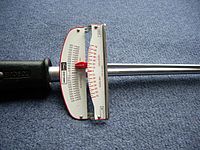Note that the units are inch-pounds, foot-pounds and ounce-inches NOT ounce/inches or inch/pounds. /QUOTE]
Yeah, I know Ron, but the slash is the only symbol that will consistently work on that page of the keyboard on my iphone without having a stick to type. If I have to send any equation stuff on the phone, I have to spell out the operand, or waste a bunch of time typing and correcting. Touch screens and I do not get along. I have trouble with the tool boxes at work, the ones in the airplane and the one on my Yaesu FTM-400 in the car. I can wear all cotton clothes and walk barefooted across a conductive floor and generate an arc when I touch a grounding bar... And to think I handle sensitive hardware and explosives for my job...

As to checking the torque values on an online conversion, it's an oddball set of values with a tiny allowable window for a set of electrical connections that are submerged in fuel. At many AMUs for a messed up fuel sending unit or harness, I take no chances on doing the non-normal conversions in my head. For most of the ones I need, I do it mentally. I normally do sub 10 inch-pound torques only a couple times a year, so I run the numbers on the computer to be safe.


